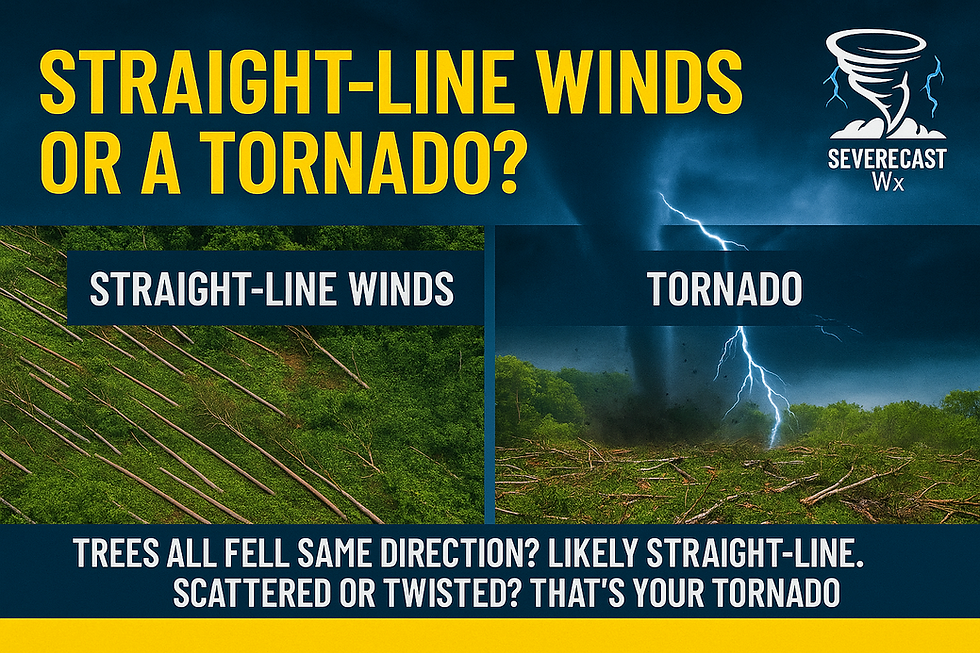The Forbidden Word: Why Tornado Warnings Were Once Banned in the United States
- Nicole Carbone
- May 4
- 3 min read
Today, tornado warnings are broadcast across every major platform and phone in seconds. Meteorologists issue alerts with precision, helping communities take life-saving action. But what if I told you that, for decades, forecasters were forbidden from saying the word "tornado"? It wasn't until the mid-20th century that the policy changed and it took scientific progress and a bold prediction to do it.

Let's rewind the clock and explore why the word tornado was banned, who enforced it, and what led to the shift in how we communicate severe weather today.
A Culture of Censorship: The Early Days of Forecasting
In the late 1800s and early 1900s, the responsibility for weather observation and forecasting in the U.S. fell to the Army Signal Corps, which later became the U.S. Weather Bureau (the predecessor to today's National Weather Service).
Under the leadership of Lt. Gen. William B. Hazen and subsequent officials, a firm policy was established: Never mention the word "tornado" in public forecasts. This decision wasn't rooted in secrecy, but in fear and uncertainty. The early belief was that announcing a tornado risk would:
Cause mass panic and disorder
Overwhelm local infrastructure
Result in unnecessary evacuations and chaos
Damage the credibility of the government if the prediction was wrong
This was a time before radar, satellites, or computer models. Tornado science was still in its infancy, and there ware no reliable ways to detect or predict these violent storms. So instead, forecasts used vague phrases like "severe local storms" or "unsettled weather," leaving the public largely in the dark about the true risks.
The Human Cost of Silence
The impact of this silence was profound. Communities were left unprepared. Tornadoes struck with no warning, no sirens, and no public advisories. People had to rely on visual sightings or barometric readings to guess whether danger was approaching.
This approach persisted well into the 20th century, even as tornadoes caused widespread devastation in places like Missouri, Oklahoma, and Illinois. Forecasters were still not allowed to use the word "tornado" publicly, even if they knew one was coming.
The Turning Point: Tinker Air Force Base, 1948
The tide began to turn in 1948 thanks to two military meteorologists: Maj. Ernest J. Fawbush and Capt. Robert C. Miller. While stationed at Tinker Air Force Base in Oklahoma, they were investigating storm damage from a tornado that had hit the base on March 20, 1948.
Just five days later, atmospheric conditions looked eerily similar. Relying on pattern recognition and observational analysis, without the tools we take for granted today, Fawbush and Miller made a daring call: they issued an internal tornado forecast for the base.
At 6:00 P.M. on March 25, another tornado struck Tinker Air Force Base, just as they had predicted. It was the first successful tornado forecast in U.S. history, and it proved that tornadoes could be anticipated with the right training and tools.
Lifting the Ban: 1950 and Beyond
The Air Force's success with forecasting brought pressure on the U.S. Weather Bureau to evolve. In 1950, the Bureau officially lifted the ban on using the word "tornado" in public forecasts. For the first time, tornado watches and warnings could be issued and communicated to the public.
This decision fundamentally changed the course of public safety and meteorology. It opened the door to modern warning systems, spotter networks, and eventually, Doppler radar and advanced modeling.
By the 1960s and 70s, with increasing trust in meteorologists and technological advances, tornado warnings became a staple of severe weather communication. Sirens, Emergency Broadcast System alerts, and televised warnings all became common.
Why This History Still Matters
It's wild to think that a single word could once be too dangerous to say, but this story is a powerful reminder of the relationship between science, policy, and public trust.
What started as a fear-driven policy evolved into one of the most vital public safety tools we have. Today's meteorologists save countless lives by warning of tornadoes well in advance, a luxury communities a century ago could only dream of.
Still, the challenges remain: conveying risk clearly, avoiding false alarms, and maintaining public trust in forecasts.
The banning of the word "tornado" may sound like something from a dystopian novel, but it's part of America's weather history. Thanks to scientific progress, bold forecasters, and changing policies, we've come a long way, and we continue to build on that legacy with each warning that is issued.





Comments